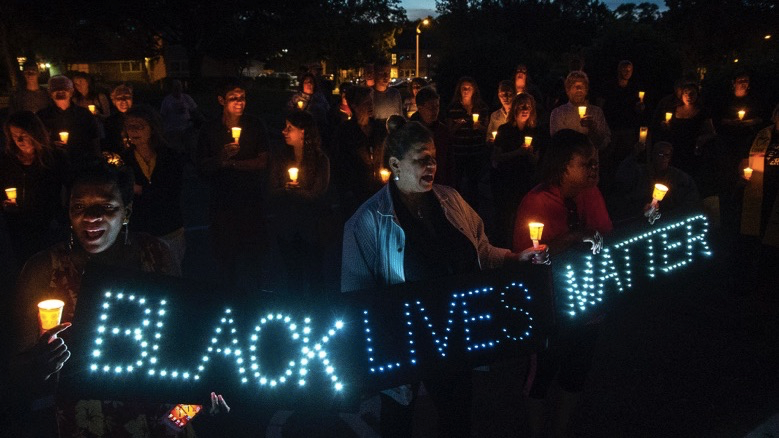
I remember watching in horror as the aftermath of Hurricane Katrina unfolded. As adults and children were trapped inside the Superdome for days. People waving from their rooftops for help that did not come. I watched. I could do nothing else.
I watched as Trayvon Martin’s killer was deemed “not guilty.” I began to speak on Facebook and with friends and family. I began to see the hard work of racial justice, as some friends reacted negatively to my posts and took to George Zimmerman’s defense. I began to read books like The New Jim Crow by Michelle Alexander to educate myself on modern institutional racism, and I helped organize a discussion about The New Jim Crow at my meeting. But mostly, I just watched.
I watched Eric Garner die on camera. “I can’t breathe.” I shared the video of his death and was immediately met with backlash from friends: “We don’t know the facts.” “Why are you so anti-cop?” I ended up deleting the video. I wasn’t ready yet. I was only ready to watch.
I watched as the story of Michael Brown’s final moments emerged. He had his hands up. He was unarmed. But no, he had a record! The cops said he was charging them!
I watched as “Black Lives Matter” rose to prominence. And I began, slowly, to speak. To speak not in spite of those who disagreed with my posts, but because of them. I joined several anti-racism groups on Facebook and found the support I needed to keep speaking.
But I did not do anything but speak, read, and watch. I did not attend any rallies, though I wanted to. I had good reason to stay home: I’m disabled and have a weakened immune system, which makes being among large crowds potentially dangerous to my health, and last fall, I was also recovering from ankle replacement surgery.
I watched as Freddie Gray died from a “rough ride.” I watched as Baltimore, the city I go to for my joint surgeries, protested. But I stayed home.
Then, on that Thursday morning, I woke. I lay in bed reading the news about the white terrorist attack on the Emanuel AME church in Charleston. The nine people who were slaughtered after spending an hour with the killer talking about the Bible. The five-year-old girl who survived by playing dead. I couldn’t stop crying.
Watching was no longer enough. When I pulled myself out of bed and left my house that day, I drove past four black people and saw each of them: two teenage boys riding their bikes down my street, one black man riding his bike and looking at his phone at the same time a couple of miles from my house, and one older black man staring at his phone in shock, standing at the side of the road. Seeing them made me tear up again, and I struggled to stay calm enough to drive safely. I wanted to let them know that I saw them and was so sorry about what had happened, but while driving is not the time to reach out to people.
I live in a town that is 70 percent white, 20 percent black, and still mostly segregated—the way most American communities are. When my husband and I were looking to purchase our first house ten years ago, I made a point of finding a street that was not all-white—this was harder than it should have been. My neighborhood is probably about half black; one of my neighbors is a widowed black woman who is surrounded on all sides by houses of family members. I felt a great need to reach out to the black people who live in my town. And I also felt a great need to worship the following Sunday, instead of staying home and resting. I knew that if I attended my Quaker meeting, my thoughts would be with Charleston’s Emanuel AME church. I wondered if there was an AME church near my home; a quick Google search revealed one less than two miles from my house.
I gave myself up to discernment, trying to find what I was led to do. I did not want to intrude upon a community in their time of mourning. I did not want to make the parishioners feel fear in their house of worship.
But the leading did not go away. So that Sunday morning, I left home to attend worship at my local AME church, accompanied by my husband. My intention was to show solidarity with them and to worship with them.
We arrived early, and the front doors of the church were locked. A black woman arrived and asked us if we were there for the service. She was warm, friendly, and inviting. We said we were, and she showed us the side door that was unlocked and explained that there was praise before the service started and that the youth group would be leading this service.
We walked into the small church, two white people left alone in their sanctuary. We did not want to make a spectacle of ourselves by sitting in the front pews, but we also didn’t want to appear as if we were hiding in the back, either. So we sat in the center pews, visible and vulnerable. The church was small and sparsely decorated but not bare like Quaker meetinghouses tend to be or overly lavish like the Catholic churches I attended growing up. The space was nearly empty; I felt like the church was waiting for its people to fill it and give it purpose.
We were alone for a good 20 minutes before the congregation began to filter in. Now I owe you readers an apology, because there is no way for me to accurately describe the worship we participated in.
There were several aspects of the service that surprised me. First, it was women-led. The reverend was a black man, but his primary participation in the service was to deliver the sermon, which occurred more than two hours into the service. Three black women seemed to lead the service, and I truly appreciated the ministry they gave, both in their words and in their actions. One of the three was the woman who had greeted us so warmly when we were searching for a way inside the church. Second, the music was all-encompassing, not a distraction from worship but a manifestation of it.
The longer the service went on, the more comfortable I felt. After the first of three hours, I began to feel a fellowship with the other worshipers and the kind of deep centering I’ve felt before only at meeting for worship. Like meeting for worship, the service felt Spirit-led: it was fluid and unpredictable, and there was space for the congregation to participate as they felt led.
There was some grief, but mostly joy. The sermon was about the first ten verses of the second chapter of Job, which I’ve read more than once, but the sermon the Reverend gave made me consider it in a whole new way. I was raised Catholic, and the overwhelming lesson I learned from Mass and CCD was that God and Jesus love you, and this fact made them worthy of worship and praise because you were a sinner and not worthy of their love. This sermon instead asked us to take the place of Job, who is described as perfect and upright. It was about keeping faith, no matter what happened. It was about the pride, joy, and determination involved in doing so. It was about gratitude to God for waking up this morning, for being able to attend this service. It was about not knowing what could happen, who could walk in the church doors, but worshiping God all the same.
I am really not doing this service justice at all. It was communion—with God and with each other. It was authentic and seemed to allow each person there to be both true to and proud of oneself while at the same time encouraging to be better.
At some point during the service, I realized that fellowship with these people—true fellowship—could not happen during just one service. I need to return, if the congregation is comfortable with me doing so. I felt blessed to be there and grateful they welcomed me in.
It has been one week now since my attendance at the local AME church, and I am still encompassed by it. I am still thinking about it. I am, surprisingly, missing it. I am eager to go back. While I have no intention of joining their church, I am hoping to become a regular visitor.
And next Sunday, I hope to attend meeting for worship and bask in that same “infinite ocean of light and love” through silence and vocal ministry instead of through the music and sound of last Sunday.



Thanks for sharing with all of us this wonderful New Post. None of us understands cultures, religions and ethnic groups different than ours unless we sincerely reach out over and over again through personal and intimate contact with one another.